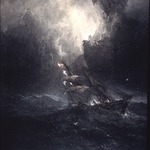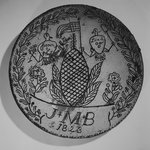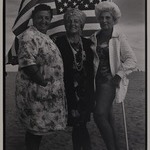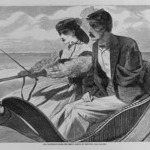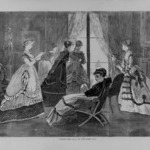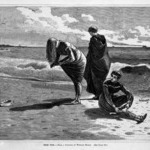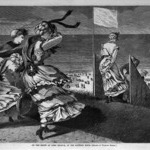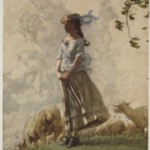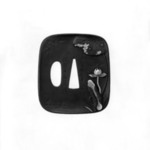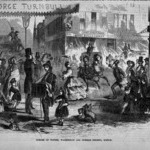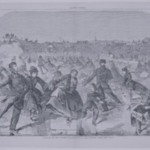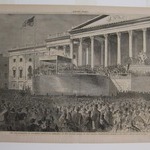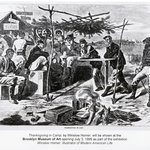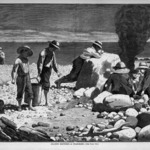
Great Sumter Meeting in Union Square, New York, April 11, 1863
Winslow Homer
American Art
Regarded as one of the great American Realists of the nineteenth century, Winslow Homer is known primarily for his large body of works in oil and watercolor. However, he also had an early career as a freelance illustrator, making drawings for wood engravings that were reproduced in mass-circulation periodicals such as Harper's Weekly. In 1998, the Brooklyn Museum received a generous gift of more than 250 wood-engraved illustrations by Homer from Harvey Isbitts.
Here, Homer illustrates a mass meeting that was held in New York on the second anniversary of the attack on Fort Sumter, which began the Civil War, "to reaffirm the determination of loyal men everywhere to prosecute the war until the rebellion is extinguished." This type of a “pep rally” was especially needed because the war was far more devastating and drawn out than the Union forces had originally envisioned and young men were paying huge sums of money to buy exemptions from conscription.
Here, Homer illustrates a mass meeting that was held in New York on the second anniversary of the attack on Fort Sumter, which began the Civil War, "to reaffirm the determination of loyal men everywhere to prosecute the war until the rebellion is extinguished." This type of a “pep rally” was especially needed because the war was far more devastating and drawn out than the Union forces had originally envisioned and young men were paying huge sums of money to buy exemptions from conscription.
MEDIUM
Wood engraving
DATES
1863
DIMENSIONS
Image: 9 x 13 3/4 in. (22.9 x 34.9 cm)
Sheet: 10 5/8 x 15 3/4 in. (27 x 40 cm)
Frame: 16 3/4 x 22 3/4 x 1 1/2 in. (42.5 x 57.8 x 3.8 cm) (show scale)



COLLECTIONS
American Art
ACCESSION NUMBER
1998.105.80
CREDIT LINE
Gift of Harvey Isbitts
EXHIBITIONS
MUSEUM LOCATION
This item is not on view
CAPTION
Winslow Homer (American, 1836–1910). Great Sumter Meeting in Union Square, New York, April 11, 1863, 1863. Wood engraving, Image: 9 x 13 3/4 in. (22.9 x 34.9 cm). Brooklyn Museum, Gift of Harvey Isbitts, 1998.105.80 (Photo: Brooklyn Museum, 1998.105.80_bw.jpg)
IMAGE
overall, 1998.105.80_bw.jpg. Brooklyn Museum photograph
"CUR" at the beginning of an image file name means that the image was created by a curatorial staff member. These study images may be digital point-and-shoot photographs, when we don\'t yet have high-quality studio photography, or they may be scans of older negatives, slides, or photographic prints, providing historical documentation of the object.
RIGHTS STATEMENT
No known copyright restrictions
This work may be in the public domain in the United States. Works created by United States and non-United States nationals published prior to 1923 are in the public domain, subject to the terms of any applicable treaty or agreement.
You may download and use Brooklyn Museum images of this work. Please include caption information from this page and credit the Brooklyn Museum. If you need a high resolution file, please fill out our online application form (charges apply).
The Museum does not warrant that the use of this work will not infringe on the rights of third parties, such as artists or artists' heirs holding the rights to the work. It is your responsibility to determine and satisfy copyright or other use restrictions before copying, transmitting, or making other use of protected items beyond that allowed by "fair use," as such term is understood under the United States Copyright Act.
The Brooklyn Museum makes no representations or warranties with respect to the application or terms of any international agreement governing copyright protection in the United States for works created by foreign nationals.
For further information about copyright, we recommend resources at the United States Library of Congress, Cornell University, Copyright and Cultural Institutions: Guidelines for U.S. Libraries, Archives, and Museums, and Copyright Watch.
For more information about the Museum's rights project, including how rights types are assigned, please see our blog posts on copyright.
If you have any information regarding this work and rights to it, please contact copyright@brooklynmuseum.org.
RECORD COMPLETENESS
Not every record you will find here is complete. More information is available for some works than for others, and some entries have been updated more recently. Records are frequently reviewed and revised, and we welcome any additional information you might have.


